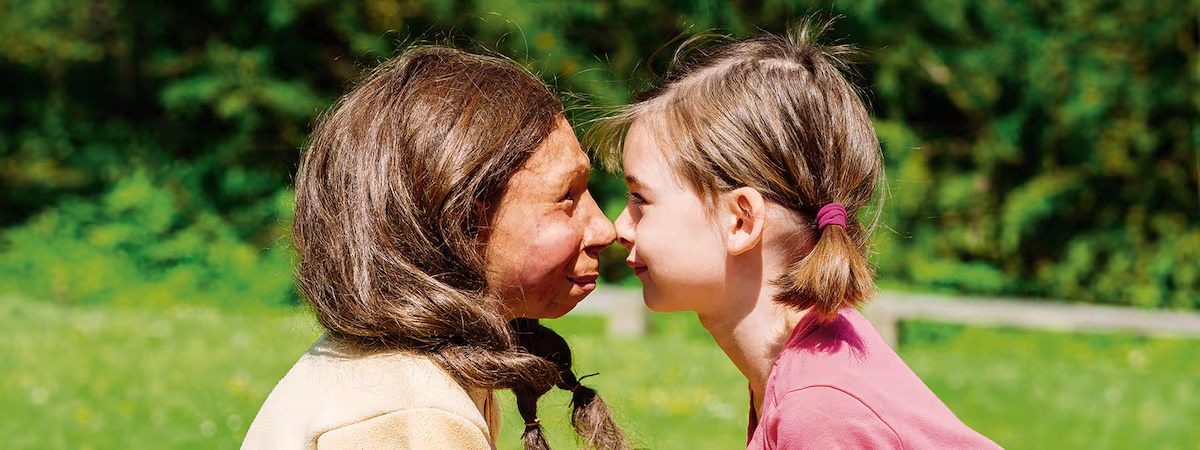Neanderthals also kissed: A gesture of love that is 21 million years old

The kiss is a great evolutionary mystery. This gesture, which involves pressing lips together with another individual, doesn’t seem to offer any advantages in reproduction or species survival, and can even cause problems, such as the transmission of diseases. However, the vast majority of humans (and many other animal species) immensely enjoy it, to the point that kissing has inspired poems, songs, paintings, and films for centuries.
Now, a study led by Oxford University has dated the beginning of this gesture, which can express love, desire, affection, or reconciliation: researchers believe it is around 21 million years old. The study has discovered that this behavior evolved in the shared ancestors of humans and other great apes, and that Neanderthals likely kissed too, with a probability of nearly 84%. The findings, published on Wednesday in the journal Evolution and Human Behavior, reveal that, far from being a recent human cultural invention, kissing is an ancient trait deeply rooted in our biology.
“This is the first time anyone has taken a broad evolutionary lens to examine kissing. Our findings add to a growing body of work highlighting the remarkable diversity of sexual behaviors exhibited by our primate cousins,” said Matilda Brindle, lead author of the study and an evolutionary biologist in the Department of Biology at Oxford, in a statement.
The Oxford team has made the first attempt to reconstruct the evolutionary history of kissing using a cross-species approach, based on the primate family tree. The first challenge was defining exactly what constitutes a kiss, something far more complex than it seems.
“Many mouth-to-mouth behaviors look like kissing, but they aren’t,” Brindle pointed out. Since the researchers were exploring kissing in different species, they needed a definition applicable to a wide range of animals. Ultimately, the one they came up with is rather prosaic: “Non-aggressive, mouth-to-mouth contact that did not involve food transfer.”
From bonobo to Neanderthal
Using this definition, researchers compiled data from the scientific literature on which modern primate species have been observed kissing. The results show that kissing is present in most great apes: chimpanzees, bonobos, and orangutans. Outside of primates, kissing has been documented in animals as diverse as polar bears, wolves, prairie dogs, and even some birds. However, there are significant differences between species: the bonobo kiss is “strikingly sensual,” the research says, while the chimpanzee kiss is “brief and tense.”
To reconstruct the evolutionary history of kissing, researchers used a statistical approach (called Bayesian modeling) to simulate different evolutionary scenarios along the branches of the tree, and thus estimate the probability that different ancestors also kissed. The model was run 10 million times to provide robust statistical estimates, they explain.
The results indicate that kissing evolved in the ancestors of great apes between 21.5 and 16.9 million years ago, after their divergence from smaller apes such as gibbons. The behavior persisted throughout evolution and is still present in most modern great apes.
“By integrating evolutionary biology with behavioral data, we’re able to make informed inferences about traits that don’t fossilize — like kissing. This lets us study social behavior in both modern and extinct species,” explained Professor Stuart West, co-author of the study and Professor of Evolutionary Biology at Oxford, in a statement.
One of the most surprising findings of the study is that Neanderthals, our extinct human relatives, very likely also kissed. The phylogenetic analysis estimates an 84.3% probability that this species practiced kissing.
This finding adds to previous studies showing that modern humans and Neanderthals shared oral microbes, specifically the bacterium Methanobrevibacter oralis, through saliva transfer. Although modern humans and Neanderthals diverged between 450,000 and 750,000 years ago, this oral microbe only separated into distinct strains between 112,000 and 143,000 years ago. This suggests that the species exchanged microbes for an extended period after their separation. “We suspected that Neanderthals probably kissed,” Brindle explained via video conference, “but it was great that we were able to confirm it. An 84% probability is a pretty strong result,” he added.
Paleoanthropologist Antonio Rosas, who did not participate in the study, believes this relationship is “somewhat weak,” since the transfer of bacteria could occur through a kiss, “but it could also be a bacterium inherited from common ancestors.”
A chimpanzee with her baby.ISABEL MUÑOZ
The study also explains that, despite being millions of years old, the act of kissing is not universal among humans. “It is only documented in 46% of human cultures,” said Catherine Talbot, co-author and assistant professor at the Florida Institute of Technology’s College of Psychology, in a statement. “The social norms and context vary widely across societies, raising the question of whether kissing is an evolved behavior or cultural invention.”
If kissing carries risks of disease transmission, there must be compensating adaptive benefits. Researchers explored several hypotheses. In a sexual context, kissing could allow for the evaluation of a potential mate’s quality through olfactory cues. It could also serve to increase pre-copulatory arousal, thus increasing the chances of fertilization. Furthermore, the data from this study suggest that premastication — parents feeding pre-chewed food to their offspring — is present in all kissing species, suggesting that kissing may have evolved from this parental care behavior.
Limitations
The study’s authors themselves acknowledge its limitations. Data is scarce, particularly outside of great apes, and most observations come from captive animals rather than wild populations. “It’s important to view our analysis as a proof of concept for future work,” Brindle cautions. The experts hope their study will establish a framework for future research and help systematize the recording of kissing behavior in non-human animals.
“This is an interesting study that opens up a new way of thinking about a behavior that appears to be universal among great apes. This means that the probability of kissing being observed in Neanderthals is high,” says Clive Finlayson, director of the Gibraltar Museum, who was not involved in the study. He also highlights several life history variables that correlate “reasonably, though not perfectly,” he says, with the presence of kissing among apes: multi-male mating systems and premastication. “Of course, we don’t know if these variables would apply to Neanderthals,” he acknowledges.
Brintle concludes his study with a quote widely attributed to the actress Ingrid Bergman: “A kiss is a lovely trick designed by nature to stop speech when words become superfluous.” A trick that, according to this new study, is 21 million years old.
Sign up for our weekly newsletter to get more English-language news coverage from EL PAÍS USA Edition





